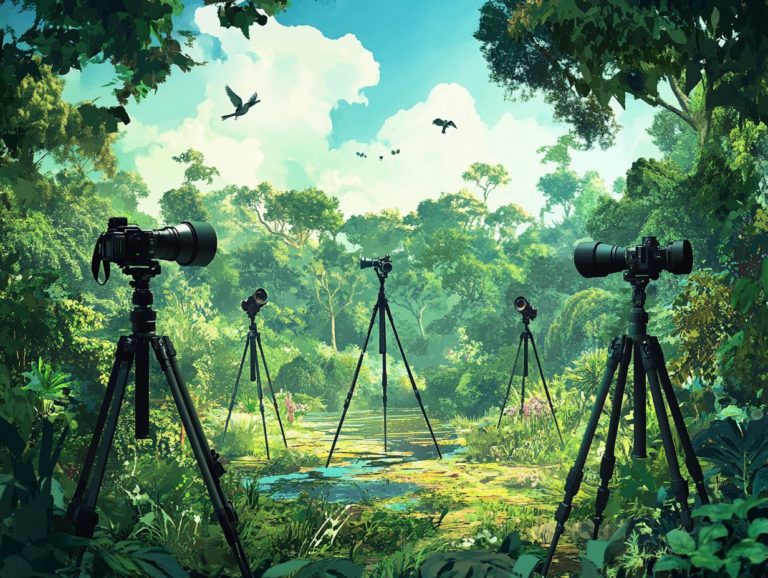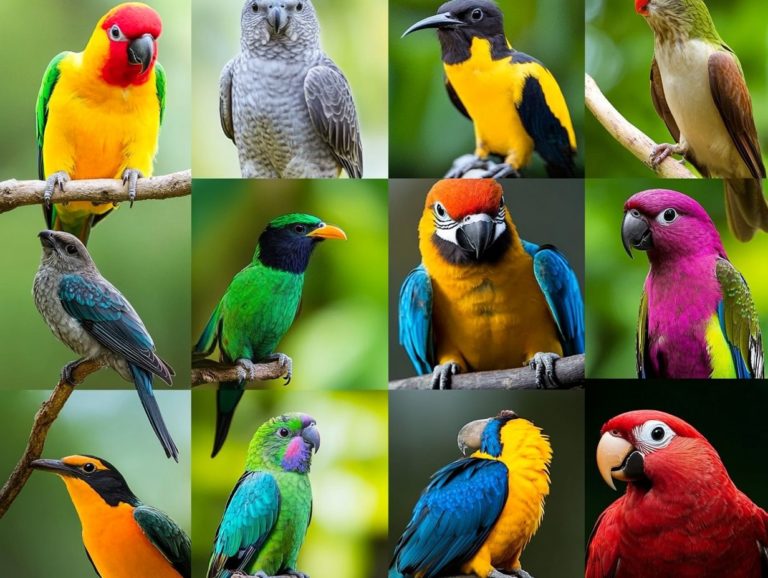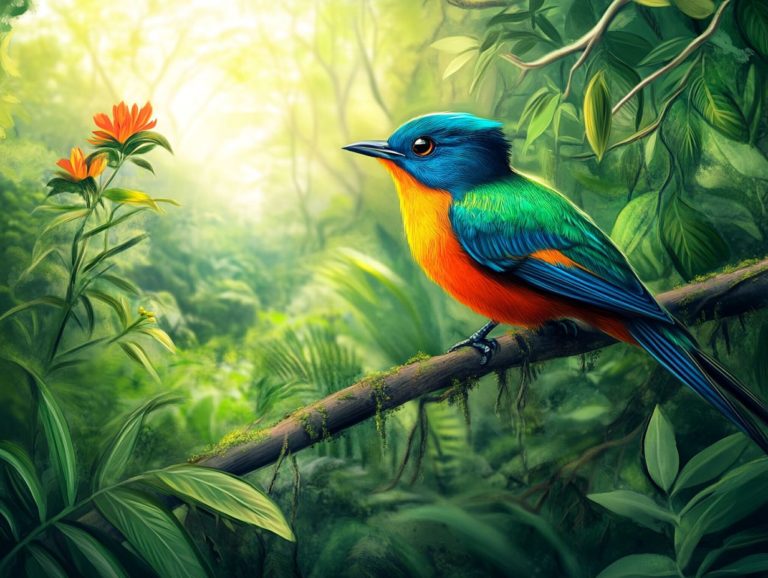The Role of Filters in Bird Photography
Bird photography is a captivating blend of art and science, demanding both skill and technique to truly capture the essence of our feathered companions.
Among the most vital instruments in this endeavor are filters. These tools enhance colors and manage light, turning a mundane photograph into a stunning visual masterpiece.
This article explores the different types of filters you can use, offers tips for effective application, and highlights common pitfalls to avoid. Arm yourself with this knowledge to elevate your bird photography!
Contents
- Key Takeaways:
- The Importance of Filters in Bird Photography
- Types of Filters Used in Bird Photography
- Choosing the Right Filter for Your Needs
- Tips for Using Filters in Bird Photography
- Common Mistakes to Avoid
- Frequently Asked Questions
- What is the role of filters in bird photography?
- What types of filters are commonly used in bird photography?
- How do polarizing filters help in bird photography?
- What is the purpose of using neutral density filters in bird photography?
- Can filters enhance colors in bird photography?
- Do I need to use filters in all my bird photography shots?
Key Takeaways:

- Filters are essential for enhancing the quality and clarity of bird photography, allowing for better control of light, color, and contrast.
- There are various types of filters used in bird photography, including polarizing, neutral density, and graduated filters, each with specific benefits.
- When choosing a filter, consider the type of birds, lighting conditions, and your desired outcome for the best results.
Overview of the Art and Techniques
Wildlife photography is an exquisite art form that captures breathtaking moments in nature. It unveils the intricate beauty of animals in their natural habitats.
To truly excel, you must go beyond simply clicking the shutter. Understanding composition is essential; using the rule of thirds can transform your images into captivating pieces that draw the viewer’s eye.
Techniques like long exposure imbue your shots with a dreamy quality, perfectly illustrating the graceful movement of a deer at dusk. The backdrop is equally important; a well-integrated environment can enhance the overall impact of your photograph.
Keeping a journal of photography tips will serve you well, whether you’re a beginner or a seasoned professional. Tracking your progress and refining your artistic vision deepens your connection with wildlife and enriches your photographic journey.
The Importance of Filters in Bird Photography
Filters are crucial for improving the visual quality of your bird photos. They help minimize unwanted reflections and enhance colors.
A Circular Polarizing filter, for example, reduces glare, allowing you to capture the true beauty of your birds. This becomes especially important in challenging lighting conditions.
Embracing high-quality filters can transform your photographic experience, turning fleeting moments into stunning captures.
How Filters Enhance Bird Photography
Filters are exceptional tools that elevate your bird photography by improving clarity, managing light, and controlling contrast. For those looking to enhance their skills, understanding exposure for bird photography can also lead to breathtaking images that showcase the vibrant colors of a bird’s plumage.
By incorporating polarizing filters, you can significantly reduce glare from water surfaces or foliage, revealing intricate details and enhancing colors in your scene.
Neutral density filters allow for longer exposure times, enabling you to create stunning effects when capturing birds in motion. Choose the right filter based on lighting conditions and your desired outcomes.
Investing in quality filters and maintaining them properly is crucial to avoid unwanted artifacts. Experimenting with different types deepens your understanding of their influence, ultimately elevating your wildlife photography.
Types of Filters Used in Bird Photography
Understanding the different types of filters is vital for anyone looking to elevate their craft. From Circular Polarizing filters to Neutral Density and Graduated Filters, each has a unique purpose that can greatly influence your final image.
By familiarizing yourself with these filters, you can select the ideal tools to enhance your photography across various lighting conditions and environments. This knowledge empowers you to capture stunning images that reflect your vision.
Now, go out and experiment with different filters! Share your photography experiences to inspire others and continue improving your skills.
Polarizing Filters
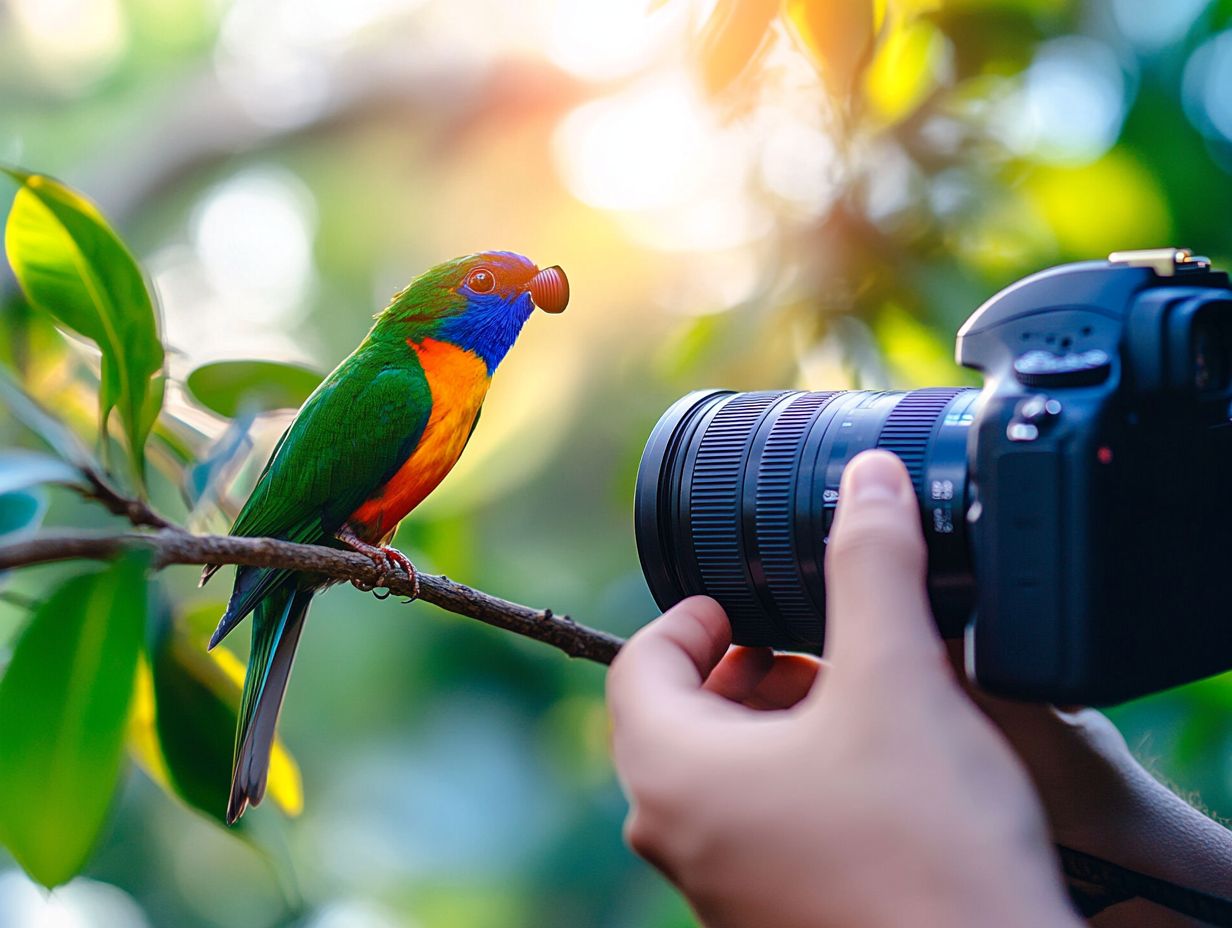
Polarizing filters, especially the Circular Polarizing filter, are essential tools for bird photographers. They minimize unwanted reflections and reduce glare in your images. These filters enhance color saturation and contrast while managing reflections off water surfaces or feathers. This results in clearer and more vibrant photographs of birds in their natural habitats.
Using these filters boosts your shots’ clarity. You’ll capture intricate feather details that might otherwise go unnoticed. For effective use, rotate the filter while observing its impact on the scene in your viewfinder. This ensures you achieve optimal results across different lighting conditions.
In bright sunlight, position the filter at a 90-degree angle to the light source for remarkable enhancements in color depth and a reduction in haze. Master these techniques today to elevate your craft! Capture stunning images that showcase the true beauty of birds.
Neutral Density Filters
Neutral Density Filters are essential tools for photographers aiming for precise light control during bird photography. These filters reduce the light entering your lens without altering the scene’s color. This allows for longer exposure times and wider apertures in bright conditions, which is particularly advantageous for capturing motion blur in birds or creating a beautifully shallow depth of field.
These filters help control bright light in open landscapes or midday sun, enhancing your overall image quality. For example, when photographing birds in flight, a Neutral Density Filter lets you use a slower shutter speed, resulting in a softly blurred background that beautifully isolates your subject.
These filters are invaluable during the golden hours of early morning or late afternoon, when light fluctuates dramatically. Choose the appropriate density based on your lighting conditions and experiment with various apertures to achieve your desired aesthetic effect.
Understanding how to pair these filters with techniques like panning and adjusting ISO settings will elevate your photography.
Graduated Filters
Graduated Filters offer a sophisticated solution for bird photographers mastering the delicate balance of exposure between the sky and their subjects, especially during the enchanting hours of sunrise and sunset. By transitioning from dark to clear, these filters manage the dynamic light range in a scene, ensuring that both the illuminated sky and the darker birds are captured beautifully.
These filters diminish light intensity in the upper portion of your frame, leading to a more harmonious overall exposure. As you work with these filters, consider the angle of your light source and adjust the filter’s position for optimal results. Experimenting with various filter strengths will help you discover the perfect balance for different shooting conditions.
Incorporating Graduated Filters into your toolkit enhances the visual impact of your images while giving you increased control over the final photograph. This results in stunning captures of avian subjects against breathtaking backgrounds, showcasing your artistry in the natural world.
Choosing the Right Filter for Your Needs
Selecting the right filter for your bird photography is essential, as the right choice can profoundly influence your outcomes. Consider various factors such as the type of photography you’re engaged in, the lighting conditions you face, and the specific attributes you aim to enhance in your images.
Investing in high-quality filters, such as those crafted by B+W KSM or Singh-Ray, can elevate your photography experience to new heights.
Factors to Consider
When selecting filters for your wildlife photography, several factors come into play that can greatly influence the outcome of your images. You’ll want to consider the type of wildlife you re photographing, the surrounding environment, and the specific lighting conditions. These can dictate the effectiveness of the filter you choose. Understanding your own photography style and needs will help you select the right filter.
For instance, when capturing birds in flight, a polarizing filter can work wonders by reducing glare from the sun and enhancing the colors and contrast in those intricate feather details. If you find yourself in a dense forest, a neutral density filter might be your best friend. It helps manage contrasting light and allows for longer exposures that beautifully capture the movement of foliage.
Don t forget that factors like the time of day and seasonal changes also play significant roles. That magical morning and evening light can create a warm, golden hue, making certain filters especially effective. You ll gain valuable experience by experimenting with different filters in various locations, leading to a deeper understanding of how each filter interacts with lighting and wildlife settings.
Tips for Using Filters in Bird Photography
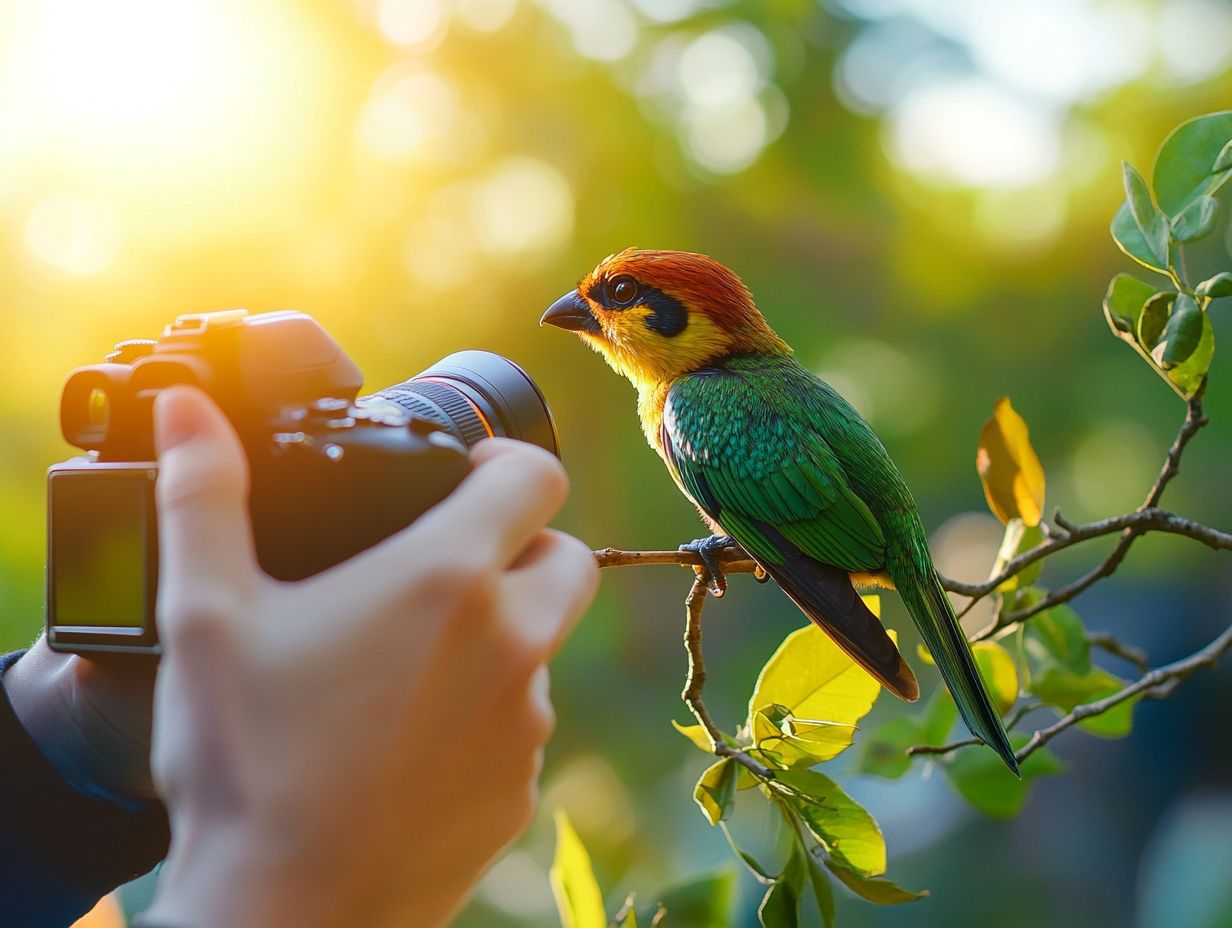
Effectively implementing filters in bird photography requires a mix of knowledge and practical skills. This can truly transform your creative output.
By embracing targeted tips such as understanding the influence of each filter on exposure and color balance you can achieve breathtaking results.
Opting for high-quality filters and mastering the appropriate techniques gives you the power to capture images of birds that truly come to life with vivid detail and beautiful colors.
Best Practices and Techniques
Adopting best practices and techniques for using filters can significantly elevate your bird photography results. This allows you to capture the essence of your subjects in a captivating manner. Experimenting with different filters in various lighting conditions and being mindful of each filter’s effects on exposure and color temperature will enhance your skills.
For instance, employing a polarizing filter can dramatically reduce glare from water and enrich the beautiful colors in a bird’s plumage, revealing stunning details that the naked eye might overlook. In overcast conditions, a graduated neutral density filter helps balance bright skies with darker landscapes, ensuring the entire scene is beautifully exposed.
UV filters not only protect your lenses but also subtly enhance contrast and clarity, particularly during photography sessions with digital SLRs. By considering your specific environment and the mood you wish to convey, you can select filters such as clear protective filters that safeguard your equipment and transform your images into breathtaking works of art.
Common Mistakes to Avoid
In the world of bird photography, it s essential to steer clear of common mistakes when it comes to filter usage. This will help you achieve optimal results. Many photographers tend to underestimate how filters interact with their gear and the shooting environment, which can lead to missed opportunities for capturing breathtaking images of birds and butterfly wings.
Recognize these pitfalls to refine your skills and elevate your wildlife photography to new heights.
Start experimenting with these filters today to take your bird photography to the next level!
How to Prevent Common Filter Errors
Preventing common filter errors in bird photography requires a careful understanding of your filters and the environment you re shooting in. Pay close attention to exposure settings and filter alignment to avoid issues like overexposure or unwanted color casts.
Take a test shot before starting your session. This allows you to make real-time adjustments and ensure everything looks just right.
Using high-quality filters can minimize distortions and maintain image clarity, especially with fast-moving birds in the Galapagos. Keep a log of your filter settings and results to enhance your future shoots.
Whether you re using polarizing filters, neutral density filters, or experimenting with various options, aim to create stunning images that accurately reflect the beauty of the avian world.
Frequently Asked Questions
What is the role of filters in bird photography?

Filters improve the quality and clarity of your images. They help you appreciate the optical quality of your shots.
What types of filters are commonly used in bird photography?
Common filters include polarizing filters, neutral density filters, and color enhancing filters like Singh-Ray and B+W KSM.
How do polarizing filters help in bird photography?
Polarizing filters reduce glare and reflections, making the colors and details of birds stand out more. This is especially effective when shooting at Brewster s angle.
What is the purpose of using neutral density filters in bird photography?
Neutral density filters reduce light entering the camera. This allows for slower shutter speeds, creating motion blur for dynamic shots.
Can filters enhance colors in bird photography?
Yes! Color enhancing filters make the vibrant colors of birds appear more vivid and eye-catching, similar to the beautiful colors seen in butterfly wings.
Do I need to use filters in all my bird photography shots?
No, filters aren t necessary for every shot. Use them strategically to enhance specific aspects of your photos, depending on your preference and desired effect.

